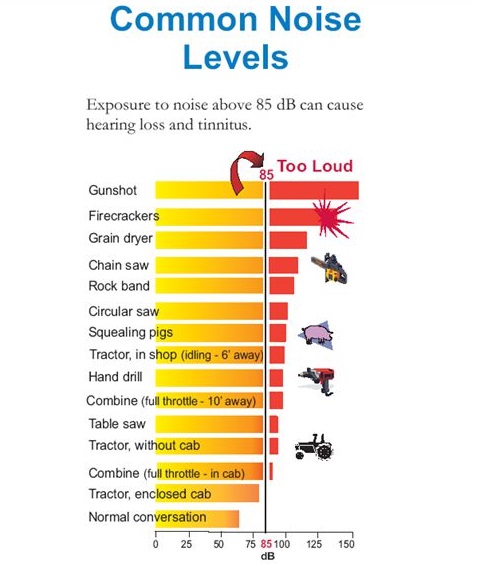Addressing Noise Exposures in Agriculture
Each year, thousands of workers suffer from preventable hearing loss due to workplace noise levels. Research has shown that those who work on farms have had significantly higher rates of hearing loss than the general population. What’s more, farming is recognized as one of the occupations with the highest levels of risk for hearing loss.
Tractors, forage harvesters, silage blowers, chain saws, skid-steer loaders, grain dryers and livestock are some of the most common sources of noise on the farm. Studies suggest that lengthy exposure to these high sound levels have resulted in noise-induced hearing loss to farmworkers of all ages.
OSHA recommends that hearing protection be used whenever workers are exposed to a sound level of 90 decibels or greater for eight hours.
Agriculture employers have a duty to protect their employees from noise exposures. Here are a number of strategies employers can use to reduce noise exposures or protect their employees from hearing loss:
- Equipment maintenance—An easy way to reduce noise levels on your farm or ranch is to pay close attention to equipment maintenance. Worn, loose or unbalanced machine parts can increase decibel levels during operation. Regular lubrication and parts replacement (e.g., bearings, mufflers and silencers) reduce friction and lower noise levels. What’s more, larger equipment at a lower speed can also reduce noise levels. Newer models of certain handheld equipment are equipped with flexible mountings to reduce noise from vibration.
- Administrative controls—Employers can control workers’ exposure to noise by rotating their work duties to limit their exposure time to jobs with high noise levels. Consider setting up a rotation program that lets workers operate a loud machine for a specific period of time, and then rotate those same workers to a less noisy task. If a person already has a hearing problem, he or she should not work in high noise areas.
- Personal protective equipment (PPE)—Use and require your employees to use PPE such as earplugs and ear muffs to reduce noise exposure.
- Early detection—If one of your workers suspects that they are suffering form hearing loss, they should be sent to an audiologist for a hearing evaluation. Hearing loss cannot be fixed once it has started, but further damage can be prevented with early detection.
For more information on occupational noise exposure, review OSHA's Safety and Health Topics Page here.
